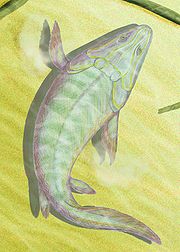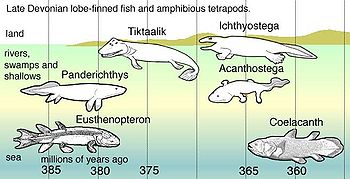
Panderichthys
Encyclopedia
Panderichthys is a 90–130 cm long fish
from the Devonian period 397 million years ago, (Frasnian
epoch) of Latvia
. It is named after the german-baltic palaeontologist Christian Heinrich Pander. It has a large tetrapod
-like head
. Panderichthys exhibits transitional
features between lobe-finned fishes and early tetrapods such as Acanthostega
, and is considered the most crownward stem fish-tetrapod with paired fins. The evolution
from fish to land dwelling tetrapods required many changes in anatomy and physiology, most importantly the legs and their supporting structure, the girdles. Well preserved fossil
s of Panderichthys clearly show these structures in transition, making Panderichthys a rare and important find in the history of life. One of the major changes in the appendicular skeleton during the transition from water to land was a shift in locomotory dominance from pectoral to pelvic appendages. Panderichthys is evidence of this because its morphology shows that the fin to limb transition began in the pectoral appendages and only later occurred in the pelvic appendages. Panderichthys is a good example of a transitional state in tetrapod evolution because its pectoral girdle shows derived characteristics while its pelvic girdle retains ancestral ones. Even though Panderichthys does not show the shift in locomotory dominance, it seems as though it was capable of some kind of shallow water or terrestrial body flexion locomotion and had the ability to prop itself up.
 Fish like Panderichthys were the ancestors of the first tetrapods, air-breathing, terrestrial animals from which the land vertebrates, including humans, are descended.
Fish like Panderichthys were the ancestors of the first tetrapods, air-breathing, terrestrial animals from which the land vertebrates, including humans, are descended.
Recent reexamination of existing Panderichthys fossils using a CT scanner shows four very clearly differentiated distal radial bones at the end of the fin skeletal structure. These finger-like bones do not show joints and they are quite short, but nonetheless show an intermediate form between fully fish-like fins and tetrapods.
In January 2010, Nature reported well-preserved and "securely dated" tetrapod tracks from Polish marine tidal flat sediments approximately 397 million years old. Therefore, Panderichthys can only be a "late-surviving relic", showing traits that evolved during the transition from fish-like creatures to tetrapods, but whose date does not reflect that transition. The tracks "force a radical reassessment of the timing, ecology and environmental setting of the fish–tetrapod transition, as well as the completeness of the body fossil record."

Fish
Fish are a paraphyletic group of organisms that consist of all gill-bearing aquatic vertebrate animals that lack limbs with digits. Included in this definition are the living hagfish, lampreys, and cartilaginous and bony fish, as well as various extinct related groups...
from the Devonian period 397 million years ago, (Frasnian
Frasnian
The Frasnian is one of two faunal stages in the Late Devonian epoch. It lasted from 385.3 ± 2.6 million years ago to 374.5 ± 2.6 million years ago. It was preceded by the Givetian stage and followed by the Famennian stage...
epoch) of Latvia
Latvia
Latvia , officially the Republic of Latvia , is a country in the Baltic region of Northern Europe. It is bordered to the north by Estonia , to the south by Lithuania , to the east by the Russian Federation , to the southeast by Belarus and shares maritime borders to the west with Sweden...
. It is named after the german-baltic palaeontologist Christian Heinrich Pander. It has a large tetrapod
Tetrapod
Tetrapods are vertebrate animals having four limbs. Amphibians, reptiles, birds and mammals are all tetrapods; even snakes and other limbless reptiles and amphibians are tetrapods by descent. The earliest tetrapods evolved from the lobe-finned fishes in the Devonian...
-like head
Head
In anatomy, the head of an animal is the rostral part that usually comprises the brain, eyes, ears, nose and mouth . Some very simple animals may not have a head, but many bilaterally symmetric forms do....
. Panderichthys exhibits transitional
Transitional fossil
A transitional fossil is any fossilized remains of a lifeform that exhibits characteristics of two distinct taxonomic groups. A transitional fossil is the fossil of an organism near the branching point where major individual lineages diverge...
features between lobe-finned fishes and early tetrapods such as Acanthostega
Acanthostega
Acanthostega is an extinct labyrinthodont genus, among the first vertebrate animals to have recognizable limbs. It appeared in the Upper Devonian about 365 million years ago, and was anatomically intermediate between lobe-finned fishes and the first tetrapods fully capable of coming onto...
, and is considered the most crownward stem fish-tetrapod with paired fins. The evolution
Evolution
Evolution is any change across successive generations in the heritable characteristics of biological populations. Evolutionary processes give rise to diversity at every level of biological organisation, including species, individual organisms and molecules such as DNA and proteins.Life on Earth...
from fish to land dwelling tetrapods required many changes in anatomy and physiology, most importantly the legs and their supporting structure, the girdles. Well preserved fossil
Fossil
Fossils are the preserved remains or traces of animals , plants, and other organisms from the remote past...
s of Panderichthys clearly show these structures in transition, making Panderichthys a rare and important find in the history of life. One of the major changes in the appendicular skeleton during the transition from water to land was a shift in locomotory dominance from pectoral to pelvic appendages. Panderichthys is evidence of this because its morphology shows that the fin to limb transition began in the pectoral appendages and only later occurred in the pelvic appendages. Panderichthys is a good example of a transitional state in tetrapod evolution because its pectoral girdle shows derived characteristics while its pelvic girdle retains ancestral ones. Even though Panderichthys does not show the shift in locomotory dominance, it seems as though it was capable of some kind of shallow water or terrestrial body flexion locomotion and had the ability to prop itself up.

Recent reexamination of existing Panderichthys fossils using a CT scanner shows four very clearly differentiated distal radial bones at the end of the fin skeletal structure. These finger-like bones do not show joints and they are quite short, but nonetheless show an intermediate form between fully fish-like fins and tetrapods.
In January 2010, Nature reported well-preserved and "securely dated" tetrapod tracks from Polish marine tidal flat sediments approximately 397 million years old. Therefore, Panderichthys can only be a "late-surviving relic", showing traits that evolved during the transition from fish-like creatures to tetrapods, but whose date does not reflect that transition. The tracks "force a radical reassessment of the timing, ecology and environmental setting of the fish–tetrapod transition, as well as the completeness of the body fossil record."
See also

- EusthenopteronEusthenopteronEusthenopteron is a genus of prehistoric lobe-finned fish which has attained an iconic status from its close relationships to tetrapods. Early depictions of this animal show it emerging onto land, however paleontologists now widely agree that it was a strictly aquatic animal...
- ElpistostegeElpistostegeElpistostege is an extinct genus of tetrapod-like fish that lived in the Late Devonian period . Fossils of skull and a part of the backbone have been found at Escuminac Formation in Quebec, Canada.-External links:* *...

